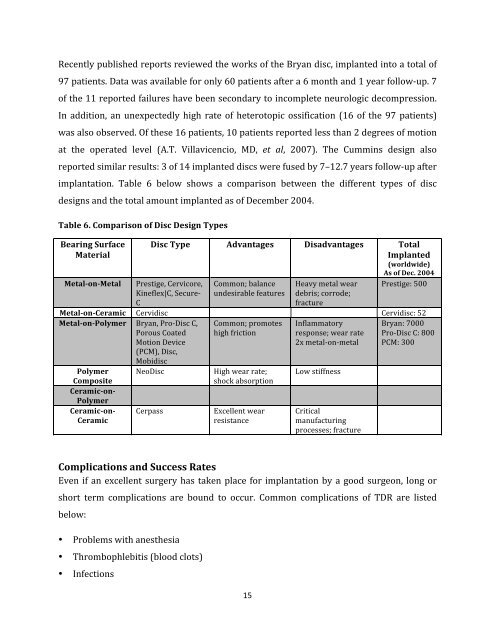Intervertebral Disk Replacement - Keivan Anbarani's Electronic ...
Intervertebral Disk Replacement - Keivan Anbarani's Electronic ...
Intervertebral Disk Replacement - Keivan Anbarani's Electronic ...
You also want an ePaper? Increase the reach of your titles
YUMPU automatically turns print PDFs into web optimized ePapers that Google loves.
Recently published reports reviewed the works of the Bryan disc, implanted into a total of<br />
97 patients. Data was available for only 60 patients after a 6 month and 1 year follow-‐up. 7<br />
of the 11 reported failures have been secondary to incomplete neurologic decompression.<br />
In addition, an unexpectedly high rate of heterotopic ossification (16 of the 97 patients)<br />
was also observed. Of these 16 patients, 10 patients reported less than 2 degrees of motion<br />
at the operated level (A.T. Villavicencio, MD, et al, 2007). The Cummins design also<br />
reported similar results: 3 of 14 implanted discs were fused by 7–12.7 years follow-‐up after<br />
implantation. Table 6 below shows a comparison between the different types of disc<br />
designs and the total amount implanted as of December 2004.<br />
Table 6. Comparison of Disc Design Types<br />
Bearing Surface<br />
Material<br />
Metal-on-Metal Prestige, Cervicore,<br />
Kineflex|C, Secure-‐<br />
C<br />
Disc Type Advantages Disadvantages Total<br />
Implanted<br />
(worldwide)<br />
As of Dec. 2004<br />
Common; balance<br />
undesirable features<br />
15<br />
Heavy metal wear<br />
debris; corrode;<br />
fracture<br />
Prestige: 500<br />
Metal-on-Ceramic Cervidisc Cervidisc: 52<br />
Metal-on-Polymer Bryan, Pro-‐Disc C,<br />
Porous Coated<br />
Motion Device<br />
(PCM), Disc,<br />
Mobidisc<br />
Polymer<br />
Composite<br />
Ceramic-on-<br />
Polymer<br />
Ceramic-on-<br />
Ceramic<br />
Common; promotes<br />
high friction<br />
NeoDisc High wear rate;<br />
shock absorption<br />
Cerpass Excellent wear<br />
resistance<br />
Inflammatory<br />
response; wear rate<br />
2x metal-‐on-‐metal<br />
Low stiffness<br />
Critical<br />
manufacturing<br />
processes; fracture<br />
Bryan: 7000<br />
Pro-‐Disc C: 800<br />
PCM: 300<br />
Complications and Success Rates<br />
Even if an excellent surgery has taken place for implantation by a good surgeon, long or<br />
short term complications are bound to occur. Common complications of TDR are listed<br />
below:<br />
• Problems with anesthesia<br />
• Thrombophlebitis (blood clots)<br />
• Infections


